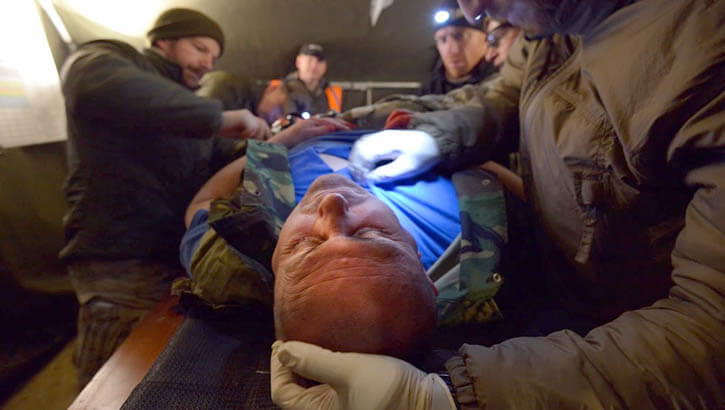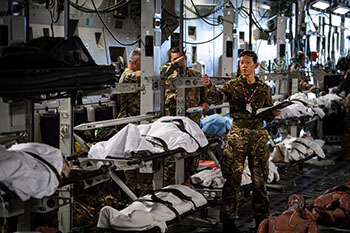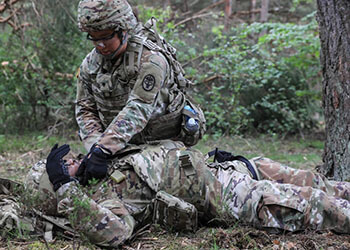How COVID-19 Made the Military Medical Community Stronger
 Multinational soldiers treat a simulated casualty during the final field training exercise of a six-month medical training course hosted by the International Special Training Centre in which twenty-four Special Operations Forces Soldiers from 10 different nations participated, March 1, 2017. (Photo: Air Force Reserve Tech. Sgt. Chris Hibben, 4th Combat Camera Squadron)
Multinational soldiers treat a simulated casualty during the final field training exercise of a six-month medical training course hosted by the International Special Training Centre in which twenty-four Special Operations Forces Soldiers from 10 different nations participated, March 1, 2017. (Photo: Air Force Reserve Tech. Sgt. Chris Hibben, 4th Combat Camera Squadron)
The international responses to the COVID-19 pandemic led to a host of changes and lessons learned across the Military Health System that will be valuable in preparing for the next crisis - whether that's another pandemic, a new conflict or natural disaster.
The far-reaching effects of the pandemic was a topic for top military health leaders from the U.S. and several other countries at an international COVID-19 panel discussion on Feb. 23. The virtual panel discussion was part of the annual meeting of AMSUS, the Society of Federal Health Officials.
"We need to manage risk in a sensible way," said Defense Health Agency Director Lt. Gen (Dr.) Ronald Place.
"As clinical leaders, we need to better explain clinical risk to our senior leaders. It's a concept they understand. But we need to put it in their language - when it's prudent to accept risk. And when it's not."
Two overarching themes emerged from the presentations: militaries continually show their flexibility in responding quickly to crises, and nations often turn to their military in times of crisis.
Major topics from the panel included:
- Preparedness
- Logistics
- Lab capacity
- Clinical guidance
- Technology infrastructure
- Communication
- Modeling and simulation
- Data management
Preparedness
Place said he gives "great credit to our public health and preventive medicine teams. They had their pandemic playbooks, and they understood the actions that needed to happen to protect individuals and populations."
From the French perspective, militaries need to improve training "during a no-crisis time" to be better prepared for crisis management. That means "an increase in interagency cooperation," said Col. (Dr.) Sandrine Duron Martinaud, head of the epidemiology and health policies evaluation unit in the Office of the French Surgeon General for the French Armed Forces Health Service.
"This would improve cooperation and mutual support, and we also need to rely better on training between the European and NATO nations," she said.
Brig. Gen. (Dr.) Duncan Wilson from the United Kingdom said his country will publish a "national crisis management guideline...during the latter part of this year." Wilson is the medical director to the Surgeon General of the British Armed Forces as well as the head of research and clinical innovation.
 British Royal Air Force Flight Lt. Laura Foster gives patient instructions to U.S. Air Force aeromedical personnel on a C-17 Globemaster III during Patriot Warrior Aug. 17, 2019, at Sparta-Fort McCoy Airport at Fort McCoy, Wisconsin ( Photo by: Air Force Reserve Tech. Sgt. Chris Hibben, 4th Combat Camera Squadron).
British Royal Air Force Flight Lt. Laura Foster gives patient instructions to U.S. Air Force aeromedical personnel on a C-17 Globemaster III during Patriot Warrior Aug. 17, 2019, at Sparta-Fort McCoy Airport at Fort McCoy, Wisconsin ( Photo by: Air Force Reserve Tech. Sgt. Chris Hibben, 4th Combat Camera Squadron).
Logistics
During the pandemic, the U.S. military's "medical logistics experts had a good line of sight on inventory of critical stockpiles," Place explained. He noted that the DOD "distributed a number of [personal protective equipment] items to our civilian partners early in the pandemic."
Canada learned "quite a bit about how vulnerable our supply chain was and the fact that we definitely need to build something stronger, and more resilient," said Maj. Gen. Marc Bilodeau, the Surgeon General of the Canadian Armed Forces. He also commanded all medical units in the western half of Canada during the pandemic.
Lab Capacity
The U.K. had to respond to its rapidly increasing COVID-19 caseload early on with better lab capabilities, mobile testing teams, and national tracing teams.
"We had to support a testing system that was a little bit slow to get off the ground and difficult to roll out across the country with quite a varied response from both urban and rural environments," Wilson said.
But quickly, the British military got boots on the ground and medical units deployed around the country. "We had a well-developed process already in place for the nation, and particularly the government departments, to reach out to the military for support," Wilson said.
In the U.S., laboratory capacity also was a concern at the beginning of the pandemic, Place said.
"We needed to work closely with civilian partners to balance explosive demand. We made significant investments in equipment and in testing supplies to be able to meet this expanded demand. And then we worked closely with industry to introduce new tests quickly after [Food and Drug Administration] approval."
Clinical Guidance
Clinical teams from across the U.S. armed services and Military Health System "came together and crafted clinical practice guidelines to provide help to our medical teams on the frontlines," Place noted.
There have been eight versions of that guidance because of the rapid knowledge increases about and medications for COVID-19, he said.
Technology
All the participants said their military and national public health systems were able to effectively handle the pandemic's infrastructure needs once the magnitude of infections was apparent. Their actions included:
- creating overflow hospital sites
- sending military teams to support overwhelmed civilian and military hospitals
- supporting overstretched caregivers and tracking their mental health
- transporting patients from over-crowded hospitals to ones with more capacity
- shifting large portions of health care services into virtual environments
 An Army medic prepares a simulated casualty for treatment during Operation Courageous Fury, a joint training exercise designed to assess medical operations in Germany at Landstuhl Regional Medical Center, June 3, 2021 (Photo by: Marcy Sanchez, Landstuhl Regional Medical Center).
An Army medic prepares a simulated casualty for treatment during Operation Courageous Fury, a joint training exercise designed to assess medical operations in Germany at Landstuhl Regional Medical Center, June 3, 2021 (Photo by: Marcy Sanchez, Landstuhl Regional Medical Center).
Communication
Communications underwent significant changes during the pandemic and became more open and transparent.
Canada's Bilodeau said "we totally changed our approach regarding using social media through the pandemic."
"Instead of staying away from it before, we are using it to communicate even with those internal to our organization."
To do so, Canada created a "fusion center helping to triage the information and make sure that it was digestible for us as medical advisers."
Similarly, in the U.K., there was a new openness about information. "Modeling was quite often exposed for all to see," Wilson said.
A lot of governmental-level decisions were based on modeling, Wilson said. Briefings included slides showing: "What if we put these measures in place? What if we don't put these measures in place? So some of that modeling became quite public property," he said.
Modeling and simulation
Modeling and simulation allowed the Canadian public health services to build new partnerships with defense scientists. Modeling and simulation also "challenges us to invest in data analytics, and computing power as well, because modeling requires a lot of computing power that we didn't have at the start of the pandemic," Bilodeau said.
He challenged the international community to "invest in technology that will be compatible with each other, so that we can share some of our database or give access to our databases."
"The more we develop that ability to share data, and ultimately to build modeling that won't be country-specific modeling, but region-specific modeling or even planet modeling, that will help us being better prepared for the next step."
Data Management
The U.S. military created a good system of tracking cases, care delivered, vaccinations, administered and many other metrics, Place said. "But we were drawing from multiple databases and systems, and there were times when data wasn't timely, and it wasn't accurate. We need to do better there," he said.
DHA Deputy Assistant Director for Medical Affairs Dr. Paul Cordts added: "I think we've come a long way in the last two years on integrating our data sources to be able to provide answers very rapidly to our most senior leaders."